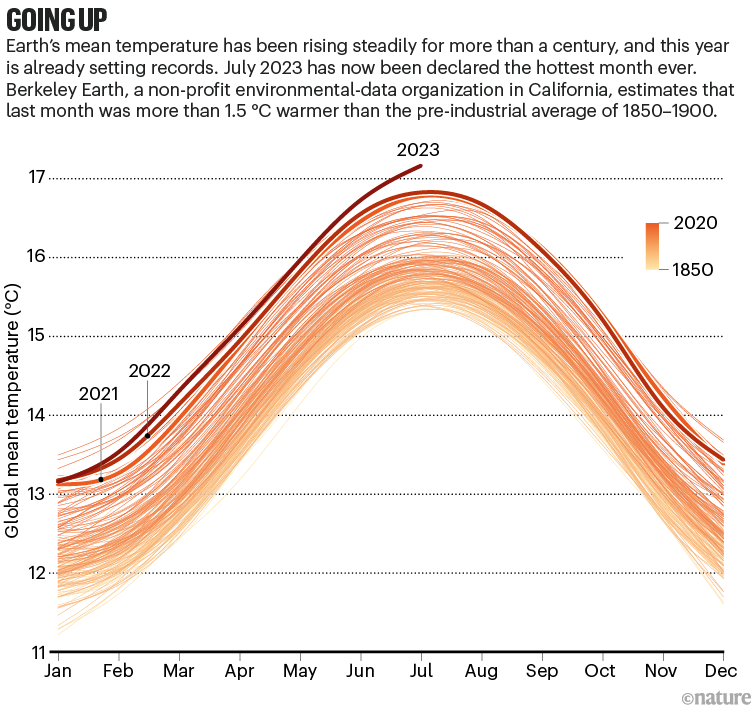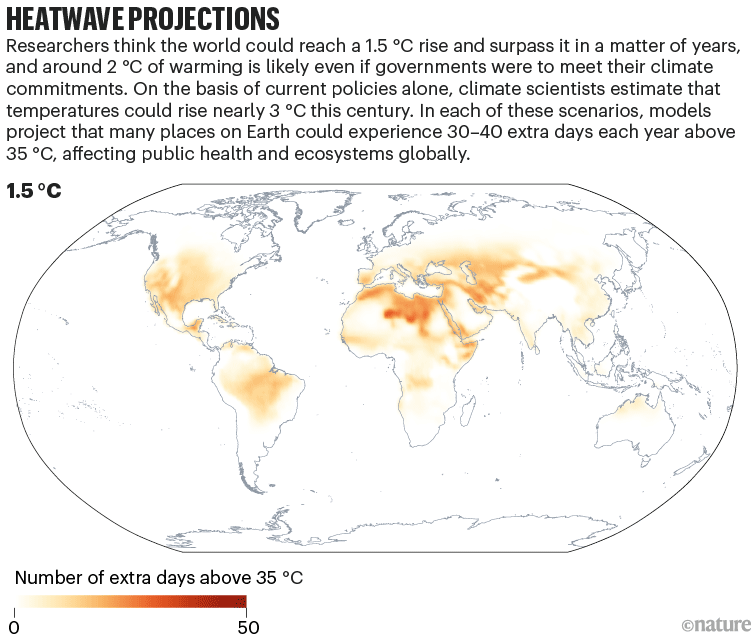

Intense heatwaves in the US desert southwest have been killing off the iconic saguaro cactus.Credit: Mario Tama/Getty
From wilting saguaros in Arizona and hot-tub-like temperatures off the coast of Florida to increased heat-related hospitalizations in Europe and agricultural losses in China, last month felt unusually hot. It was: several teams have now confirmed that July 2023 was the hottest month in recorded history. And there’s more to come.
July is typically the hottest month of the year, and this July shattered records going back as far as 1850 by around 0.25 °C. Overall, the average global temperature was 1.54 °C above the preindustrial average for July, according to Berkeley Earth, a non-profit group in California that is one of several organizations tracking global warming. It’s a seemingly small increase, but what many people across the world actually experienced was a bout of long and often brutal heat waves.
“We’re in a particularly extreme period on top of a long-term warming trend, and the view from the top is a little scary,” says Zeke Hausfather, a climate scientist at Berkeley Earth.
Loading the dice
Multiple factors might have played a small part in the record-breaking temperatures, including a budding El Niño warming event in the equatorial Pacific Ocean and a volcanic eruption last year on the island of Tonga that injected water vapour, itself a powerful greenhouse gas, into the stratosphere. New regulations have also curbed the release of sulphur dioxide pollution from ships, which tends to have a cooling effect. But the biggest driver by far, scientists say, is increasing greenhouse-gas concentrations in the atmosphere, which have been steadily raising average global temperatures and have loaded the dice in favour of extreme weather and climate events (see ‘Going up’).

Source: Berkeley Earth
An analysis by scientists at the World Weather Attribution initiative found that the heatwave in China last month would have been expected only once every 250 years in a world without human influence. Temperatures in southern Europe and North America, meanwhile, would have been “virtually impossible” in the preindustrial era. But such extremes are becoming the norm: last month’s events can now be expected every 5–15 years, and could happen as often as every 2–5 years if global temperatures increase to 2 °C above preindustrial levels, the upper limit imposed by the 2015 Paris climate agreement.
“It only takes a small change in average temperature for the frequency of extremes to completely blow out, which is what we’ve seen in the Northern Hemisphere recently,” says Sarah Perkins-Kirkpatrick, a climate scientist at the University of New South Wales in Sydney, Australia.
Local troubles
Global average temperature, often measured on a rolling ten-year basis, is a metric that scientists use to track broad trends in a noisy, complex system. Thus far, the world has warmed by 1.14 °C using that metric. But no one actually lives in an average world. And although 90% of the excess heat due to the presence of greenhouse gases has gone into the oceans, the fact is that temperatures over land are both warmer and rising faster than those of the ocean surface. Many parts of the Earth’s land surface have already warmed by more than 1.5 °C in at least one season, and temperatures in numerous places last month were as much as 8 °C above the average for July (see ‘Hot spots’).

Source: Berkeley Earth
To some extent, this should come as no surprise. The Paris agreement limits of 1.5–2 °C were intended to establish a relatively safe zone that, if maintained, would prevent many of the most severe impacts of a warming world. But a key message from the 2021–22 assessment of the Intergovernmental Panel on Climate Change is that every tenth of a degree of warming at the global level comes with additional — and often extreme — impacts at the local and regional level.
A few decades ago, many of those impacts were theoretical, but a growing body of research suggests that the planet is beginning to breach important ecological thresholds, says Jofre Carnicer, an ecologist at the University of Barcelona in Spain. Carnicer says that temperature and precipitation trends are already pushing many parts of Europe into entirely new fire regimes, evidenced by extreme wildfires in Greece and elsewhere this year1.
Heat waves rising
Global temperature trends have tracked fairly well with projections from climate models going back more than two decades, but research into what that means at the local level is just beginning, Carnicer says (see ‘Heatwave projections’). “This is really new science,” he says, and it suggests that even the low threshold of a 1.5 °C average — which could be breached for the first time in the next several years — might be a significant challenge for the world.

Source: IPCC
The science makes one thing clear: the warming shows no sign of stopping. This year’s El Niño event is just getting started, and many scientists suspect that 2023 could be the hottest on record. Next year is likely to be even warmer.
“July 2023 is just the latest in a long run of extremely warm months and years,” says Sarah Kapnick, chief scientist for the National Oceanic and Atmospheric Administration. “The long-term increase in global temperature marches on and on and on.”
Source link




